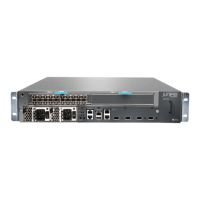CHAPTER 10
Transceiver and Cable Specifications
•
Determining Transceiver Support for MX5, MX10, MX40, and MX80 3D Universal Edge
Routers on page 65
•
Understanding Fiber-Optic Cable Signal Loss, Attenuation, and Dispersion on page 66
•
Calculating Power Budget and Power Margin for Fiber-Optic Cables on page 67
•
Routing Engine Interface Cable Specifications for MX5, MX10, MX40, and MX80
Routers on page 69
Determining Transceiver Support for MX5, MX10, MX40, and MX80 3D Universal Edge
Routers
You can find information about the optical transceivers supported on your Juniper device
by using the Hardware Compatibility Tool. In addition to transceiver and connection type,
the optical and cable characteristics–where applicable–are documented for each
transceiver. The HardwareCompatibility Tool enables you to search by product, displaying
all the transceivers supported on that device, or category, by interface speed or type. The
list of supported transceivers for the MX5, MX10, MX40, and MX80 3D Universal Edge
Routers is located at https://pathfinder.juniper.net/hct/category/.
CAUTION: If you face a problem running a Juniper Networks device that uses
a third-party optic or cable, the Juniper Networks Technical Assistance Center
(JTAC) can help you diagnose the source of the problem. Your JTAC engineer
might recommend that you check the third-partyoptic or cableand potentially
replace it with an equivalent Juniper Networks optic or cable that is qualified
for the device.
Related
Documentation
MX5, MX10, MX40, and MX80 Modular Interface Card Description on page 23•
65Copyright © 2017, Juniper Networks, Inc.

